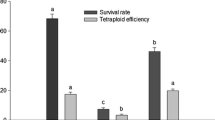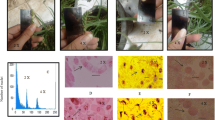Summary
The effect of the tissue culture system, the genotype and the ploidy level of the plant material used as explant source on the stability of the ploidy level of plants regenerated fromcell and tissue cultures of tomato was investigated. In addition the use of the chloroplast number in guard cells as a measure for ploidy level was evaluated. Haploids of tomato were very instable, which instability was observed already in somatic root tip and leaf cells. The number of regenerated plants that retained the original ploidy level differed significantly between the tested haploids. The plants that were regenerated from leaf explants of diploids were predominantly diploid in contrast to the plants regenerated from established callus cultures and protoplast where the majority was tetraploid.
Similar content being viewed by others
References
Ancora G. & K. Sree Ramulu, 1981. Plant regeneration of stem internodes in self-incompatible triploid Lycopersicon peruvianum Mill. and cytogenetic analysis of regenerated plants. Plant Science Letters 22: 197–204.
Benton W. & K.L. Bastian, 1986. Karyotypic variation among protoplast-derived tomato plants. In: D.A. Somers, B.G. Gengenbach, D.D. Biesboer, W.P. Hackett & C.E. Green (Eds.), International Congress of plant tissue and cell culture. Abstracts, p. 216, University of Minnesota, Minneapolis.
Cappadocia M. & K. Sree Ramulu, 1980. Plant regeneration from in vitro cultures of anthers and stem internodes in an interspecific hybrid, Lycopersicon esculentum x L. peruvianum Mill. and cytogenetic analysis of the regeneration plants. Plant Science Letters 20: 145–149.
Ecochard R., M.S. Ramanna & D. de Nettancourt, 1969. Detection and cytological analysis of tomato haploids. Genetica 40: 181–190.
Evans D.A. & W.H. Sharp, 1983. Single gene mutations in tomato plants regenerated from tissue culture. Science 221: 949–951.
Frandsen N.O., 1968. Die Plastidenzahl als merkmal bei der Kartoffel. Theoretical and Applied Genetics 38: 153–167.
Jacobsen E., 1981. Polyploidization in leaf callus tissue and in regenerated plants of diploid potato. Plant Cell Tissue Organ Culture 1: 77–84.
Karp A. & S.W.J. Bright, 1985. On the causes and origins of somaclonal variation. Oxford Surveys of Plant Molecular & Cell Biology 2: 199–234.
Karp A., R. Risiott, M.G.K. Jones & S.W.J. Bright, 1984. Chromosome doubling in monohaploid and dihaploid potatoes by regeneration from cultured leaf explants. Plant Cell Tissue Organ Culture 3: 363–373.
Koornneef M., C.J. Hanhart, M. Jongsma, I. Toma, R. Weide, P. Zabel & J. Hille, 1986. Breeding of a tomato genotype readily accessible to genetic manipulation. Plant Sci. 45: 201–208.
Koornneef M., C.J. Hanhart & L. Martinelli, 1987. A genetic analysis of cell culture traits in tomato. Theor. Appl. Genet. 74: 633–641.
Larkin P.J. & W.R. Scowcroft, 1981. Somaclonal variation — a novel source of variability from cell cultures for plant improvement. Theor. Appl. Genet. 60: 197–214.
McCormick S., J. Miedermeyer, J. Fry, A. Barnason, R. Horsch & R. Fraley, 1986. Leaf disc transformation of cultivated tomato (L. esculentum) using Agrobacterium tumefaciens. Plant Cell Reports 5: 81–84.
O'Connell M.A., L.P. Hosticka & M.R. Hanson, 1987. Examination of genome stability in cultured Lycopersicon. Plant Cell Reports 5: 276–279.
Savage A.D., J. King & O.L. Gamborg, 1979. Recovery of a pantothenate auxotroph from a suspension culture of Datura innoxia (Mill.). Plant Science Letters 16: 367–376.
Sibi, M., 1982. Heritable epigenic variations from in vitro tissue culture of Lycopersicon esculentum (var. Monalbo). In: E.E. Earle & Y. Demarly (Eds). Variability in plants regenerated from tissue culture. Praeger Publishers, pp 228–244.
Sibi, M., 1986. Non-mendelian heredity-genetic analysis of variant plants regenerated from in vitro culture: epigenetics and epigenic. In: J. Semal (Ed.). Somaclonal variations and crop improvement. Martinus Nijhoff Publishers, pp. 53–84.
Sree Ramulu, K. 1986. Case histories of genetic variability in vitro: Potato. In: I.K. Vasil (Ed.). Cell Culture and somatic cell genetics of plants vol. 3. Academic Press, pp 449–473.
Sree Ramulu K., M. Devreux, G. Ancora & K. Laneri, 1976. Chimaerism in Lycopersicon peruvianum plants regenerated from in vitro cultures of anthers and stem internodes. Z. Pflanzenzüchtung 76: 299–319.
Tan M.M.C., H.S. Boerrigter & A.J. Kool, 1987. A rapid procedure for plant regeneration from protoplasts isolated from suspension cultures and leaf mesophyll cells of wild Solanum species and Lycopersicon pennellii. Plant Science 49: 43–72.
Tempelaar M.J., E. Jacobsen, M.A. Ferwerda & M. Hartogh, 1985. Changes of ploidy levels by in vitro culture of monohaploid and polyploid clones of potato. Z. Pflanzenzüchtung 95: 193–200.
Uijtewaal B.A., 1987. Ploidy variability in greenhouse cultured in vitro propagated potato monohaploids (2n=x=12) as determined by flow cytometry. Plant Cell Reports 6: 252–255.
Wijbrandi J., J.G.M. Vos & M. Koornneef, 1988. Transfer of regeneration capacity from Lycopersicon peruvianum to L. esculentum by protoplast fusion. Plant Cell and Organ Culture. 12: 193–196.
Author information
Authors and Affiliations
Rights and permissions
About this article
Cite this article
Koornneef, M., van Diepen, J.A.M., Hanhart, C.J. et al. Chromosomal instability in cell- and tissue cultures of tomato haploids and diploids. Euphytica 43, 179–186 (1989). https://doi.org/10.1007/BF00037911
Received:
Accepted:
Issue Date:
DOI: https://doi.org/10.1007/BF00037911




